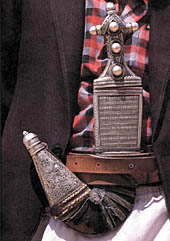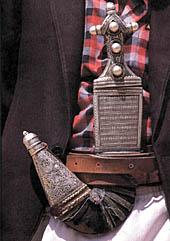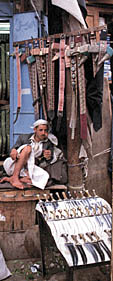
Jambia: Great National Handicraft [Archives:1998/38/Culture]
September 21 1998

One of the most famous handicrafts in Yemen is the jambia industry. It is an economic activity which has its own markets, especially in the former north Yemen. People of Yemen feel very proud of the jambia considering it complementary to their traditional clothes.
It is like a dagger with an arrowhead and is worn in the middle of the body. The value of a jambia is dependent on its age, i.e. the older it is, the more expensive it becomes. It is not just a weapon rather it is a phallic symbol and a gift of history to Yemenis. When a person wears his jambia it is a sign of his becoming a man otherwise he is treated as a woman.
Jambia’s History
The history of the jambia goes back to the pre-Islamic period where it was used in warring similar to the sword but it was shorter and worn on the side of the body. The Yemeni used to carry it with him wherever he went because of the many inter-tribal wars talking place during that time. But the jambia underwent some changes and development until it took this present shape.
The jambia is composed of three main parts: sheath, arrowhead and belt. The sheath is made of leather which can be colored in green or brown. Some sheathes are also made of silver and sometimes are decorated with gold. But they are unusual today. Until the seventies of this century, a pocket used to be made behind the sheath for keeping some instruments like a comb, mirror, etc.
It is only the well-to-do who wear very costly jambias prices of which can extend to hundreds of thousands or even millions of riyals. It is the handgrip of the jambia that defines the price. The expensive jambias are of handgrips made of the horn of the rhinoceros brought from India and the African Horn. But the cheap ones are made of the horn of the gazelle and ibex. In the past it was made of metal.
With regard to the arrowhead, it is made of steel and nickel; it usually has bright color. And the best kind is the Haddramy relating to Hadhramaut governorate and then comes the Kadibby.
The belt which carries the jambia is made of leather. Some wise phrases are written on the belt usually in golden threads adding some beauty to it.
Jambia & Social Standing

But it should be remembered that the jambia wearing habit has begun to be less common in society owing to development and economic hardship. People don’t like to wear cheap jambias. Also because of the prohibition of arm-carrying in public institutions this has limited the number of people wearing the jambia. This is visible in Taiz, Aden and Hodeidah. During the Imam’s rule people were enforced to adhere to their traditional clothes but they are free to wear whatever they like today.
Jambias & Conflicts
The Yemeni people try their best not to use the jambia in their conflicts. And a person will not stab his enemy in the back because that is a sign of cowardice. If the person has taken his jambia out of its sheath, he has to ‘tab’ his rival otherwise his is considered cowardly. In the tribal society there is nothing between cowardice and recklessness. Taking the sheath out without using it seldom happens. The other possibility is known as the hajar which means that some sheep have to be slaughtered to the two rivals or enemies within the presence of their relatives; it is a sign of eliminating the disputes between them.
The Jambia’s Status
The jambia is worn in many parts of the country, particularly in the northern part. It is one the most important elements in practicing some of the religious and festival rituals like Al-Barra dance which can never take place without it. Some dervishes use it in stabbing themselves, with no harm, in order to attract the attention of the people to their miraculous powers. It is also very important in wagering according to the tribal system of disputes. The two opponents hand their jambias over to an arbitrator who can be sometimes the tribe shiekh. Giving the jambias to him is an indication of the acceptance of the judgment of the arbitrator. The two jambias are not given back before the declaration of the judgment.
And due to the important status of the jambia in society, some people believe that it can be instrumental in disillusioning the people from the spell of evil spirits. People in Yemen like the jambia very much and always keep it away from water which can make the sheath rusty. Water also affects the handgrip, the most important part of the jambia. They also try to make the arrowhead very shiny and bright.
Yemen is an industrial country and from this comes the name of the capital Sanaa. There are a lot of workshops in Sanaa today for many handicrafts, one of which is jambia making. There are also some centers for learning such handicrafts. The handicrafts shops owners are complaining that their products are not marketable these days because they are confiscated from the tourists at the airport under the pretext of preserving the rare objects. However, the jambias sellers have affirmed that the old jambias are not sold.
In order that ancient jambias do not meet the same destiny as some of the silver and copper, we should follow the following so as to protect this valuable handicraft:
1- Appoint specialized people at airports to differentiate the ancient from the new products.
2- Employ graduates at the handicrafts teaching centers.
3- Encourage the handicraftsmen in order to preserve this profession restricting it only to people of experience in this field.
We also appeal to the people in charge in the Ministry of Culture and Tourism and that of Industry to hold exhibitions inside and outside Yemen in order to market this handicraft and show it to the world.
By: Ehab Ameen Al-Saqqaf
——
[archive-e:38-v:1998-y:1998-d:1998-09-21-p:./1998/iss38/culture.htm]


